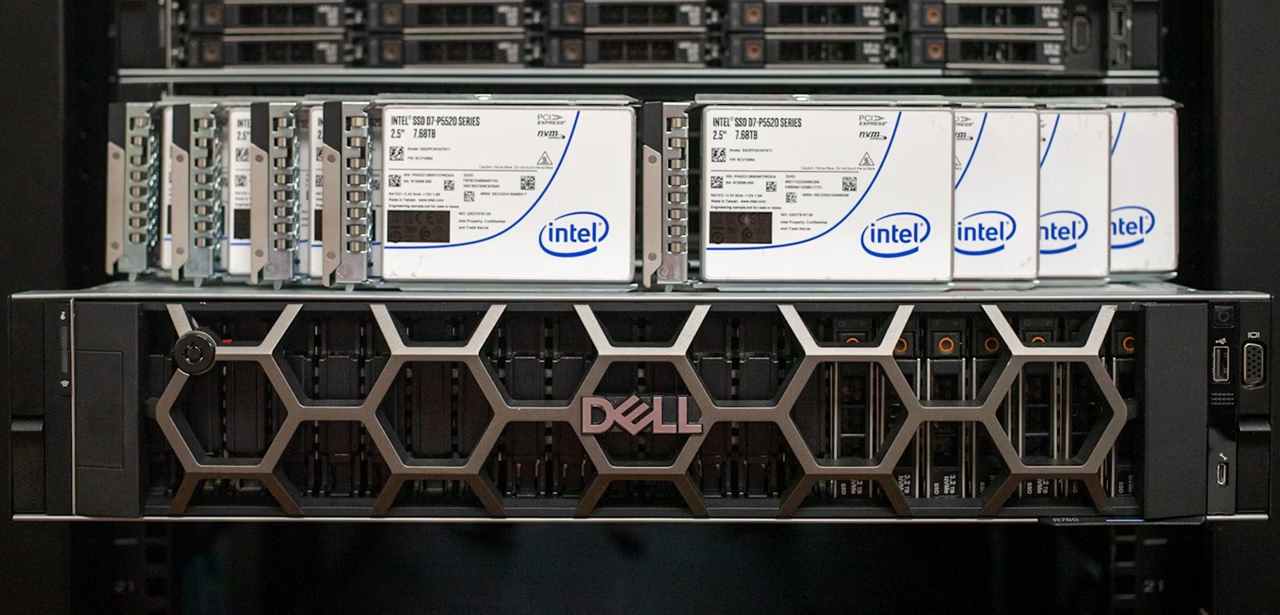Dell PowerEdge Direct Drives vs PERC 12
Storage Review Summary


For data centers using 4th generation storage hardware in their servers, Dell offers two primary options for managing a fully populated array of Gen4 NVMe U.2 or U.3 SSDs: Direct Drives and PERC 12 HWRAID cards. In their recently published guide, Storage Review examines the performance of each of these options.
Dell PERC 12 overview
Based on Broadcom SAS4116W silicon chip architecture, the DellPowerEdge RAID Controller (PERC) 12 is a tri-mode RAID-on-Chip (ROC) device. As most data center builds leverage the "H965i Front" PERC 12 card, Storage Review tested an R760 system with HWRAID and two H965i Front cards: one for each set of eight Solidigm D7-P5520 SSDs.
Before comparing PERC 12 HWRAID’s performance against that of Direct Drives, Storage Review shows the clear performance advantage of PERC 12 over the older PERC 11.
Dell Direct Drives vs. Dell PERC 12 Performance
Testing the performance of Dell PERC 12 technology versus that of Dell Direct Drives, Storage Review set up two tests to compare the two configurations. The two configurations are as follows:
- The first configuration is a Direct Drives PowerEdge R760 server unit with 8 Solidigm D7-P5520 7.68TB Gen4 SSDs connected directly to the CPU.
- The second configuration is a HWRAID NVMe PowerEdge R760 server unit with 16 Solidigm P5520 7.68TB Gen4 SSDs, each in an array of 8 connected to a PERC 12 H965i card.
The first test used Vdbench workloads to measure JBOD performance of with eight SSDs (with no optimizations) passed through to each R760 server unit. The second test showed scaled performance the dual-card PERC 12 solution.
First Test Results
The initial metric targeted in the first test was read transfer bandwidth, which showed Direct Drives with a clear advantage at 41.6 GB/s, versus 28 GB/s from a single PERC 12 in JBOD mode. Moving to write bandwidth, the Direct Drives configuration measured 18.3 GB/s while the PERC 12 configuration measured 20.3 GB/s.
For a 4K random read workload, the Direct Drive’s 8-SSD configuration PowerEdge R760 measured 5.55M IOPS peak, compared to the PERC 12 setup’s 4.34M IOPS. For a 4K random write workload, the Direct Drive configuration measured 3.96M IOPS versus 4.15M IOPS from the PERC 12.
For mixed workloads, a 4K random transfer test with a 70/30 read/write split yielded a 4.47M IOPS peak for the Direct Drives and a 3.66M IOPS peak for the PERC 12 configuration. The same test run again with a 90/10 read/write split yielded a 5.04M IOPS peak for the Direct Drives and a 3.62M IOPS peak for the PERC 12 configuration.
Second Test Results: FIO Workload Analysis
Will Dell’s innovative approach of using a dual PERC 12 configuration to solve the bandwidth limit inherent in the x16 PCIe Gen4 slot width of a single PERC 12 card, better storage performance can be achieved for larger workloads. As Storage Review shows in comprehensive results tables available in the full article, this configuration presents significant performance advantages over the Direct Drive configuration when two CPUs are utilized and NUMA balancing comes into play. For such applications, the article concludes with the final takeaway: “Dell's new PERC12 NVMe RAID card changes the game for NVMe storage options in PowerEdge servers.”
For more, read the full article at Storage Review when you click the button.